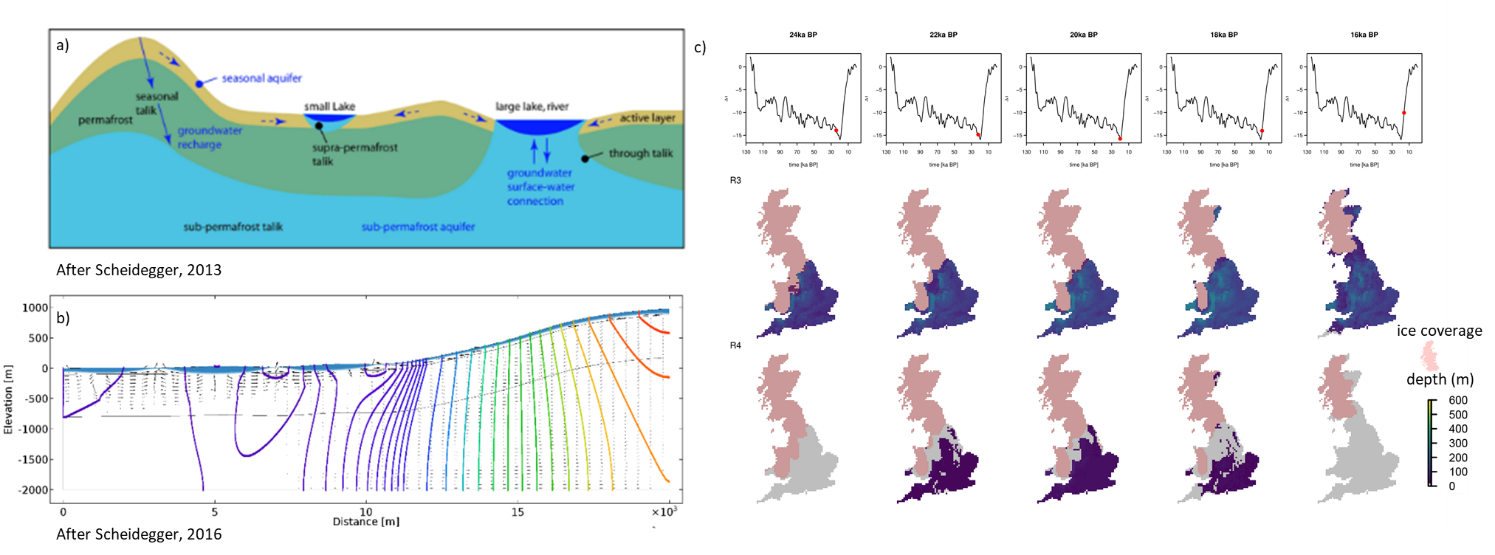Melting and refreezing processes brought about by glaciers and permafrost influence terrestrial water cycling, including groundwater flow dynamics. This has important implications for global water security and energy infrastructure.
The global extent of glacier ice and permafrost is intrinsically linked to changes in global temperature, which, over millennia, have caused the glacial/interglacial cycles that alter our geological environment. Predicting how glaciation will influence groundwater flow behaviour over these timescales is fundamental to ensuring the long-term safety of geological disposal facilities.
At shorter timescales, climate change is accelerating glacier retreat around the world, threatening water security for millions of people globally. At BGS, we develop models of glacial, periglacial and permafrost environments to investigate the effect of climate and cryosphere processes on terrestrial water cycling. We have two key research themes: glacial water resources modelling, and periglacial and permafrost hydrology.
Glacial water resources modelling
Glaciers supplement the water supply of millions of people globally, yet they are retreating rapidly as mean global temperatures rise. The environmental modelling team develops and applies models of glacier dynamics (mass balance and ice flow) and foreland hydrology to investigate the effect of climate change on downstream water supply. We apply our models at catchment to global scales to understand the propagation of change from the climate to both the cryosphere and downstream surface water and groundwater sources.
Our research is helping to diagnose current and future water supply vulnerabilities and work towards adaptation options. As well as using our own glacier-hydrology modelling software, we use the Joint UK Land Environment Simulator (JULES) land-surface model and Open Global Glacier Model (OGGM) glacier dynamics models.

Left: conceptual model of the glacierised Virkisjökull catchment and foreland hydrology in Iceland; right: simulated groundwater contribution to a glacier-fed river under climate change using a model developed at the BGS. BGS © UKRI 2020.
Periglacial and permafrost hydrology
Permafrost is defined as ground that remains at or below 0°C for two or more consecutive years.
Permafrost has a large effect on the groundwater flow system, as the pore space is clogged by ice and restricts water flow. Groundwater recharge and discharge is limited to unfrozen zones, which are called taliks, below, above or throughout the permafrost.
We study how long-term climate change affects both permafrost development and the change in the groundwater flow system, as well as how the two are interlinked, by using numerical models of coupled heat and fluid flow. We use our models to understand permafrost and groundwater flow development for both past climate change over the timeframe of glacial/interglacial cycles and future time periods. This is relevant to the lifetime of a geological disposal facility in the UK, for example.

Conceptual model of groundwater flow in permafrost environments: a) simulated permafrost distribution with b) hydraulic head equipotential lines of a cross-sectional model of coupled permafrost and groundwater flow; c) time slices of permafrost distribution and ice sheet coverage on UK mainland during the last glaciation considering two scenarios of surface air temperature. BGS © UKRI.
Contact
If you require further information on glacial water resources research, please contact Dr Jonathan Mackay.
For further information on periglacial and permafrost hydrology, please contact Dr Johanna Scheidegger.



